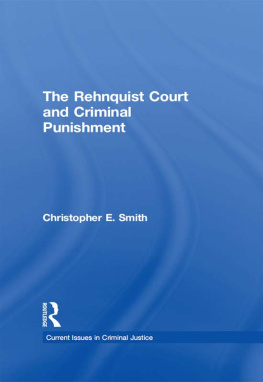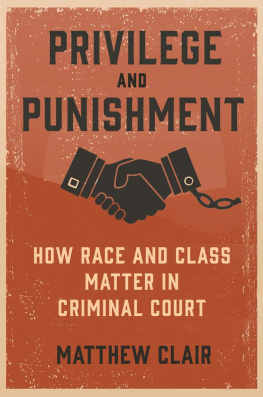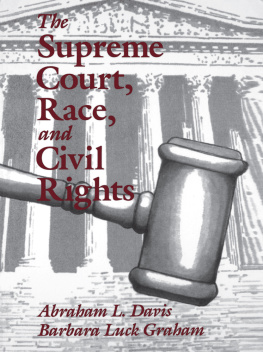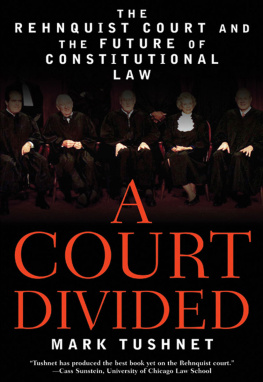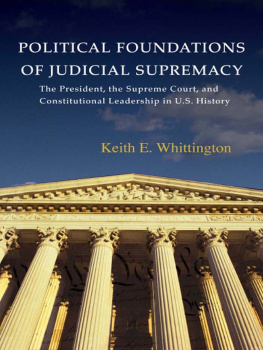THE REHNQUIST COURT AND CRIMINAL PUNISHMENT
CURRENT ISSUES IN CRIMINAL JUSTICE
VOLUME 21
GARLAND REFERENCE LIBRARY OF SOCIAL SCIENCE
VOLUME 1137
CURRENT ISSUES IN CRIMINAL JUSTICE
FRANK P. WILLIAMS III AND MARILYN D. MCSHANE
Series Editors
STRANGER VIOLENCE
A Theoretical Inquiry
by Marc Riedel
CRIMES OF STYLE
Urban Graffiti and the Politics of Criminality
by Jeff Ferrell
UNDERSTANDING CORPORATE CRIMINALITY
edited by Michael B. Blankenship
POLITICAL CRIME IN CONTEMPORARY AMERICA
A Critical Approach
edited by Kenneth D. Tunnell
THE MANAGEMENT OF CORRECTIONAL INSTITUTIONS
by Marilyn D. McShane and Frank P. Williams III
INNOVATIVE TRENDS AND SPECIALIZED STRATEGIES IN COMMUNITY-BASED CORRECTIONS
edited by Charles B. Fields
THE WINDS OF INJUSTICE
American Indians and the U.S. Government
by Laurence French
ALTERED STATES OF MIND
Critical Observations of the Drug War
edited by Peter Kraska
CONTROLLING STATE CRIME
An Introduction
edited by Jeffrey Ian Ross
MEDIA, PROCESS, AND THE SOCIAL CONSTRUCTION OF CRIME
Studies in Newsmaking Criminology
edited by Gregg Barak
ACADEMIC PROFESSIONALISM IN LAW ENFORCEMENT
by Bernadette Jones Palombo
AFRICAN-AMERICAN ORGANIZED CRIME
A Social History
by Rufus Schatzberg and Robert J. Kelly
AFRICAN AMERICANS AND THE CRIMINAL JUSTICE SYSTEM
by Marvin D. Free, Jr.
POLICING CHANGE, CHANGING POLICE
International Perspectives
edited by Otwin Marenin
ENVIRONMENTAL CRIME AND CRIMINALITY
Theoretical and Practical Issues
edited by Sally M. Edwards, Terry D. Edwards, and Charles B. Fields
THE CONTOURS OF PSYCHIATRIC JUSTICE
A Postmodern Critique of Mental Illness, Criminal Insanity; and the Law
by Bruce A. Arrigo
THE SOUTHERN SUBCULTURE OF DRINKING AND DRIVING
A Generalized Deviance Model for the Southern White Male
by Julian B. Roebuck and Komanduri S. Murty
COMPARATIVE DELINQUENCY
India and the United States
by Clayton A. Hartjen and Sesha Kethineni
RACE, GENDER, AND CLASS IN CRIMINOLOGY
The Intersection
edited by Martin D. Schwartz and Dragan Milovanovic
THE REHNQUIST COURT AND CRIMINAL PUNISHMENT
by Christopher E. Smith
POSTMODERN CRIMINOLOGY
by Dragan Milovanovic
First published 1997 by Garland Publishing, Inc.
This edition published 2013 by Routledge
711 Third Avenue, New York, NY 10017
2 Park Square, Milton Park, Abingdon, Oxon OX14 4RN
Routledge is an imprint of the Taylor & Francis Group, an informa business
Copyright 1997 by Christopher E. Smith
All rights reserved
Library of Congress Cataloging-in-Publication Data
Smith, Christopher E.
The Rehnquist court and criminal punishment / by Christopher E. Smith.
p. cm. (Garland reference library of social science ; v. 1137. Current issues in criminal justice ; v. 21 )
Includes bibliographical references and index.
ISBN 0-8153-2573-8 (alk. paper)
1. PunishmentUnited StatesHistory. 2. United States. Supreme CourtHistory. I. Title. II. Series: Garland reference library of social science ; v. 1137. III. Series: Garland reference library of social science. Current issues in criminal justice ; v. 21.
KF9225.S64 1997
SERIES EDITORS FOREWORD
There could not be a more opportune time for Christopher E. Smiths book on the Supreme Court and punishment. In an organized and easily readable format, Smith takes us through the sentencing and incarceration issues that have been so controversial and yet, in a twist of irony, so relatively unchanged over the years. Although specific procedures and policies may evolve, the general nature and tendencies of punishment appear to remain somewhat stable in our society. This informative and insightful document attests to a legacy of excess and paradox.
It is ironic indeed that the Court, the institution set up to insure that the government does not trample on the rights of individual citizens, is criticized for giving those citizens too many rights. When the court does what it was engineered to do- insure a system of checks and balances and provide guidance for Constitutional complianceit is chastized and ridiculed by an angry citizenry and media. Although the Supreme Court is theoretically a reflection of the values and standards of contemporary society, it seems to satisfy few.
While police actions and trial proceedings appear to generate public debate and media attention, the inner workings of the prison are still somewhat closed and secretive. In discussions of basic rights and protections, the Eighth Amendment has become the other amendmentless analyzed and theorized about than the others. Professor Smiths work begins to rectify this slight. The Rehnquist Court and Criminal Punishment provides a much needed commentary about contemporary punishment. Smith wisely leaves the reader to draw any conclusions about justice in the criminal justice system.
Marilyn D. McShane
Frank P. Williams III
Crime continues to be a problem that captures the attention of the news media, researchers, government officials, and the American public. It simultaneously inspires fear in the public, fear that is fed by the messages we receive from the media and politicians. Our inability to stop crime is not surprising in light of the myriad and diverse causes of crime and motivations of lawbreakers. Competing politicians are not deterred by our lack of success as they perpetually promise the public that they, and not their political opponents, know best how to handle the crime problem. Of course, because crime is not easily controlled, elected officials must find actions that are actually within their powers and exploit those actions to demonstrate their effective leadership against crime and criminals. The element of criminal justice most readily grasped and shaped by politicians is the definition of punishment for criminal offenses. They cannot control crime, but they can impose severe punishments on those individuals who are caught and convicted. In particular, the highly touted War on Drugs has not stopped drug abuse, but it has contributed to a tripling of American prison populations during the past fifteen years even as crime rates for many violent offenses have declined.
The recent emphasis on long prison terms, despite their questionable efficacy, raises many questions about the impact of increasingly punitive policies. Many of these questions concern larger expenditures: Will state governments threaten their own financial health by continuing to build expensive new prisons? Will the public be willing to pay additional taxes to incarcerate larger numbers of convicted offenders without demonstrable evidence that this costly incarceration is, in fact, reducing crime in a cost effective manner? Will citizens sacrifice government support for education, roads, and other services in order to spend more money on criminal justice institutions? These fiscal policy issues will be determined by the interactions of voters, legislatures, and governors.

